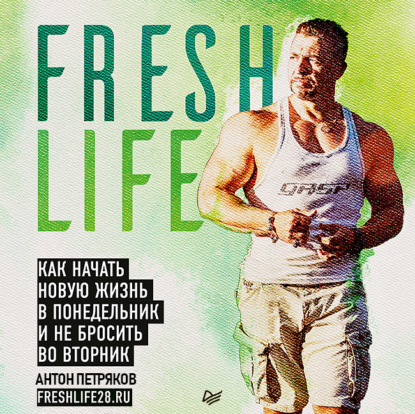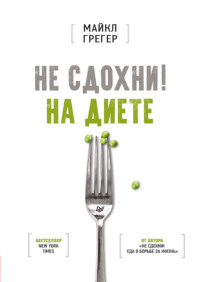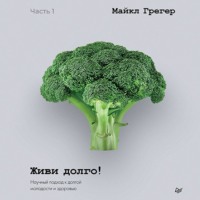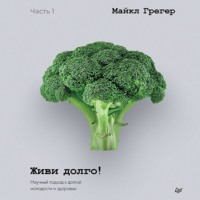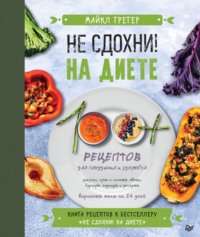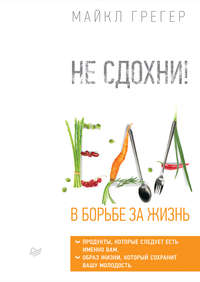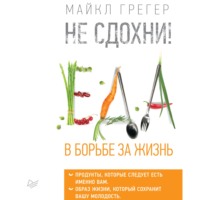
Полная версия
Живи долго! Научный подход к долгой молодости и здоровью
3171
Fan WJ, Hou YT, Sun XH, et al. Effect of high-fat, standard, and functional food meals on esophageal and gastric pH in patients with gastroesophageal reflux disease and healthy subjects. J Dig Dis. 2018;19(11):664–73. https://pubmed.ncbi.nlm.nih.gov/30270576/
3172
Katz PO, Gerson LB, Vela MF. Guidelines for the diagnosis and management of gastroesophageal reflux disease. Am J Gastroenterol. 2013;108(3):308–28. https://pubmed.ncbi.nlm.nih.gov/23419381/
3173
Newberry C, Lynch K. The role of diet in the development and management of gastroesophageal reflux disease: why we feel the burn. J Thorac Dis. 2019;11(Suppl 12):S1594–601. https://pubmed.ncbi.nlm.nih.gov/31489226/
3174
Jung JG, Kang HW. Vegetarianism and the risk of gastroesophageal reflux disease. In: Vegetarian and Plant-Based Diets in Health and Disease Prevention. Elsevier; 2017:463–72. https://www.sciencedirect.com/science/article/abs/pii/B9780128039687000253?via%3Dihub
3175
Law MR, Hackshaw AK. A meta-analysis of cigarette smoking, bone mineral density and risk of hip fracture: recognition of a major effect. BMJ. 1997;315(7112):841–6. https://pubmed.ncbi.nlm.nih.gov/9353503/
3176
Patel RA, Wilson RF, Patel PA, Palmer RM. The effect of smoking on bone healing. Bone Joint Res. 2013;2(6):102–11. https://pubmed.ncbi.nlm.nih.gov/23836474/
3177
Kim JH, Patel S. Is it worth discriminating against patients who smoke? A systematic literature review on the effects of tobacco use in foot and ankle surgery. J Foot Ankle Surg. 2017;56(3):594–9. https://pubmed.ncbi.nlm.nih.gov/28476393/
3178
Bourne D, Plinke W, Hooker ER, Nielson CM. Cannabis use and bone mineral density: NHANES 2007–2010. Arch Osteoporos. 2017;12(1):29. https://pubmed.ncbi.nlm.nih.gov/28286929/
3179
Sophocleous A, Robertson R, Ferreira NB, McKenzie J, Fraser WD, Ralston SH. Heavy cannabis use is associated with low bone mineral density and an increased risk of fractures. Am J Med. 2017;130(2):214–21. https://pubmed.ncbi.nlm.nih.gov/27593602/
3180
Cosman F, de Beur SJ, LeBoff MS, et al. Clinician’s guide to prevention and treatment of osteoporosis. Osteoporos Int. 2014;25(10):2359–81. https://pubmed.ncbi.nlm.nih.gov/25182228/
3181
Wright J. Marketing disease: is osteoporosis an example of “disease mongering”? Br J Nurs. 2009;18(17):1064–7. https://pubmed.ncbi.nlm.nih.gov/19798007/
3182
Hudson B, Zarifeh A, Young L, Wells JE. Patients’ expectations of screening and preventive treatments. Ann Fam Med. 2012;10(6):495–502. https://pubmed.ncbi.nlm.nih.gov/23149525/
3183
Black DM, Rosen CJ. Postmenopausal osteoporosis. N Engl J Med. 2016;374(21):2096–7. https://pubmed.ncbi.nlm.nih.gov/26789873/
3184
Lems WF, Raterman HG. Critical issues and current challenges in osteoporosis and fracture prevention. An overview of unmet needs. Ther Adv Musculoskelet Dis. 2017;9(12):299–316. https://pubmed.ncbi.nlm.nih.gov/29201155/
3185
Kolata G. Fearing drugs’ rare side effects, millions take their chances with osteoporosis. The New York Times. https://www.nytimes.com/2016/06/02/health/osteoporosis-drugs-bones.html. Published June 1, 2016. Accessed March 6, 2022.; https://www.nytimes.com/2016/06/02/health/osteoporosis-drugs-bones.html
3186
Sales LP, Pinto AJ, Rodrigues SF, et al. Creatine supplementation (3 g/d) and bone health in older women: a 2-year, randomized, placebo-controlled trial. J Gerontol A Biol Sci Med Sci. 2020;75(5):931–8. https://pubmed.ncbi.nlm.nih.gov/31257405/
3187
Candow DG, Forbes SC, Kirk B, Duque G. Current evidence and possible future applications of creatine supplementation for older adults. Nutrients. 2021;13(3):745. https://pubmed.ncbi.nlm.nih.gov/33652673/
3188
NIH Consensus Development Panel on Osteoporosis Prevention, Diagnosis, and Therapy. Osteoporosis prevention, diagnosis, and therapy. JAMA. 2001;285(6):785–95. https://pubmed.ncbi.nlm.nih.gov/11440324/
3189
Nestle M, Nesheim MC. To supplement or not to supplement: the U.S. Preventive Services Task Force recommendations on calcium and vitamin D. Ann Intern Med. 2013;158(9):701–2. https://pubmed.ncbi.nlm.nih.gov/23440174/
3190
Grossman DC, Curry SJ, Owens DK, et al. Vitamin D, calcium, or combined supplementation for the primary prevention of fractures in community-dwelling adults: US Preventive Services Task Force recommendation statement. JAMA. 2018;319(15):1592–9. https://pubmed.ncbi.nlm.nih.gov/29677309/
3191
Bolland MJ, Grey A, Reid IR. Calcium supplements and cardiovascular risk: 5 years on. Ther Adv Drug Saf. 2013;4(5):199–210. https://pubmed.ncbi.nlm.nih.gov/25114781/
3192
Reid IR, Bristow SM, Bolland MJ. Calcium supplements: benefits and risks. J Intern Med. 2015;278(4):354–68. https://pubmed.ncbi.nlm.nih.gov/26174589/
3193
Reid IR, Bolland MJ. Risk factors: calcium supplements and cardiovascular risk. Nat Rev Cardiol. 2012;9(9):497–8. https://pubmed.ncbi.nlm.nih.gov/22776986/
3194
Bischoff-Ferrari HA, Dawson-Hughes B, Baron JA, et al. Calcium intake and hip fracture risk in men and women: a meta-analysis of prospective cohort studies and randomized controlled trials. Am J Clin Nutr. 2007;86(6):1780–90. https://pubmed.ncbi.nlm.nih.gov/18065599/
3195
Bolland MJ, Grey A, Reid IR. Calcium supplements and cardiovascular risk: 5 years on. Ther Adv Drug Saf. 2013;4(5):199–210. https://pubmed.ncbi.nlm.nih.gov/25114781/
3196
Willett WC, Ludwig DS. Milk and health. N Engl J Med. 2020;382(7):644–54. https://pubmed.ncbi.nlm.nih.gov/32053300/
3197
Dawson-Hughes B, Jacques P, Shipp C. Dietary calcium intake and bone loss from the spine in healthy postmenopausal women. Am J Clin Nutr. 1987;46(4):685–7. https://pubmed.ncbi.nlm.nih.gov/3661483/
3198
Sanders KM, Stuart AL, Williamson EJ, et al. Annual high-dose oral vitamin D and falls and fractures in older women: a randomized controlled trial. JAMA. 2010;303(18):1815–22. https://pubmed.ncbi.nlm.nih.gov/20460620/
3199
Ginde AA, Blatchford P, Breese K, et al. High-dose monthly vitamin D for prevention of acute respiratory infection in older long-term care residents: a randomized clinical trial. J Am Geriatr Soc. 2017;65(3):496–503. https://pubmed.ncbi.nlm.nih.gov/27861708/
3200
Bischoff-Ferrari HA, Dawson-Hughes B, Orav EJ, et al. Monthly high-dose vitamin D treatment for the prevention of functional decline: a randomized clinical trial. JAMA Intern Med. 2016;176(2):175–83. https://pubmed.ncbi.nlm.nih.gov/26747333/
3201
Smith LM, Gallagher JC, Suiter C. Medium doses of vitamin D decrease falls and higher doses of daily vitamin D3 increase falls: a randomized clinical trial. J Steroid Biochem Mol Biol. 2017;173:317–22. https://pubmed.ncbi.nlm.nih.gov/28323044/
3202
Burt LA, Billington EO, Rose MS, Raymond DA, Hanley DA, Boyd SK. Effect of high-dose vitamin D supplementation on volumetric bone density and bone strength: a randomized clinical trial. JAMA. 2019;322(8):736–45. https://pubmed.ncbi.nlm.nih.gov/31454046/
3203
Burt LA, Billington EO, Rose MS, Kremer R, Hanley DA, Boyd SK. Adverse effects of high-dose vitamin D supplementation on volumetric bone density are greater in females than males. J Bone Miner Res. 2020;35(12):2404–14. https://pubmed.ncbi.nlm.nih.gov/31454046/
3204
Iuliano S, Hill TR. Dairy foods and bone health throughout the lifespan: a critical appraisal of the evidence. Br J Nutr. 2019;121(7):763–72. https://pubmed.ncbi.nlm.nih.gov/30638442/
3205
Byberg L, Warensjö-Lemming E. Milk consumption for the prevention of fragility fractures. Nutrients. 2020;12(9):E2720. https://pubmed.ncbi.nlm.nih.gov/32899514/
3206
Willett WC, Ludwig DS. Milk and health. N Engl J Med. 2020;382(7):644–54. https://pubmed.ncbi.nlm.nih.gov/32053300/
3207
Phillip A. Study: milk may not be very good for bones or the body. The Washington Post. https://www.washingtonpost.com/news/to-your-health/wp/2014/10/31/study-milk-may-not-be-very-good-for-bones-or-the-body/. Published October 31, 2014. Accessed March 23, 2022.; https://www.washingtonpost.com/news/to-your-health/wp/2014/10/31/study-milk-may-not-be-very-good-for-bones-or-the-body/
3208
Michaëlsson K, Wolk A, Langenskiöld S, et al. Milk intake and risk of mortality and fractures in women and men: cohort studies. BMJ. 2014;349:g6015. https://pubmed.ncbi.nlm.nih.gov/25352269/
3209
Cui X, Wang L, Zuo P, et al. D-galactose-caused life shortening in Drosophila melanogaster and Musca domestica is associated with oxidative stress. Biogerontology. 2004;5(5):317–25. https://pubmed.ncbi.nlm.nih.gov/15547319/
3210
Cui X, Zuo P, Zhang Q, et al. Chronic systemic D-galactose exposure induces memory loss, neurodegeneration, and oxidative damage in mice: protective effects of R-alpha-lipoic acid. J Neurosci Res. 2006;84(3):647–54. https://pubmed.ncbi.nlm.nih.gov/16555301/
3211
Simoons FJ. A geographic approach to senile cataracts: possible links with milk consumption, lactase activity, and galactose metabolism. Dig Dis Sci. 1982;27(3):257–64. https://pubmed.ncbi.nlm.nih.gov/6804198/
3212
Sella R, Afshari NA. Nutritional effect on age-related cataract formation and progression. Curr Opin Ophthalmol. 2019;30(1):63–9. https://pubmed.ncbi.nlm.nih.gov/30320615/
3213
Ding M, Li J, Qi L, et al. Associations of dairy intake with risk of mortality in women and men: three prospective cohort studies. BMJ. 2019;367:l6204. https://pubmed.ncbi.nlm.nih.gov/31776125/
3214
Grey A, Bolland M. Web of industry, advocacy, and academia in the management of osteoporosis. BMJ. 2015;351:h3170. https://pubmed.ncbi.nlm.nih.gov/26198274/
3215
Byberg L, Warensjö-Lemming E. Milk consumption for the prevention of fragility fractures. Nutrients. 2020;12(9):E2720. https://pubmed.ncbi.nlm.nih.gov/32899514/
3216
Willett WC, Ludwig DS. Milk and health. N Engl J Med. 2020;382(7):644–54. https://pubmed.ncbi.nlm.nih.gov/32053300/
3217
Dai Z, Kroeger CM, Lawrence M, Scrinis G, Bero L. Comparison of methodological quality between the 2007 and 2019 Canadian dietary guidelines. Public Health Nutr. 2020;23(16):2879–85. https://pubmed.ncbi.nlm.nih.gov/32552917/
3218
Ausman LM, Oliver LM, Goldin BR, Woods MN, Gorbach SL, Dwyer JT. Estimated net acid excretion inversely correlates with urine pH in vegans, lacto-ovo vegetarians, and omnivores. J Ren Nutr. 2008;18(5):456–65. https://pubmed.ncbi.nlm.nih.gov/18721741/
3219
Kerstetter JE, O’Brien KO, Caseria DM, Wall DE, Insogna KL. The impact of dietary protein on calcium absorption and kinetic measures of bone turnover in women. J Clin Endocrinol Metab. 2005;90(1):26–31. https://pubmed.ncbi.nlm.nih.gov/15546911/
3220
Dawson-Hughes B, Harris SS, Ceglia L. Alkaline diets favor lean tissue mass in older adults. Am J Clin Nutr. 2008;87(3):662–5. https://pubmed.ncbi.nlm.nih.gov/18326605/
3221
Groesbeck DK, Bluml RM, Kossoff EH. Long-term use of the ketogenic diet in the treatment of epilepsy. Dev Med Child Neurol. 2006;48(12):978–81. https://pubmed.ncbi.nlm.nih.gov/17109786/
3222
Heikura IA, Burke LM, Hawley JA, et al. A short-term ketogenic diet impairs markers of bone health in response to exercise. Front Endocrinol (Lausanne). 2020;10:880. https://pubmed.ncbi.nlm.nih.gov/32038477/
3223
Simm PJ, Bicknell-Royle J, Lawrie J, et al. The effect of the ketogenic diet on the developing skeleton. Epilepsy Res. 2017;136:62–6. https://pubmed.ncbi.nlm.nih.gov/28778055/
3224
Bergqvist AG, Schall JI, Stallings VA, Zemel BS. Progressive bone mineral content loss in children with intractable epilepsy treated with the ketogenic diet. Am J Clin Nutr. 2008;88(6):1678–84. https://pubmed.ncbi.nlm.nih.gov/19064531/
3225
Yancy WS, Olsen MK, Dudley T, Westman EC. Acid-base analysis of individuals following two weight loss diets. Eur J Clin Nutr. 2007;61(12):1416–22. https://pubmed.ncbi.nlm.nih.gov/17299473/
3226
Gunaratnam K, Vidal C, Gimble JM, Duque G. Mechanisms of palmitate-induced lipotoxicity in human osteoblasts. Endocrinology. 2014;155(1):108–16. https://pubmed.ncbi.nlm.nih.gov/24169557/
3227
Mozaffari H, Djafarian K, Mofrad MD, Shab-Bidar S. Dietary fat, saturated fatty acid, and monounsaturated fatty acid intakes and risk of bone fracture: a systematic review and meta-analysis of observational studies. Osteoporos Int. 2018;29(9):1949–61. https://pubmed.ncbi.nlm.nih.gov/29947872/
3228
Frassetto L, Sebastian A. Age and systemic acid-base equilibrium: analysis of published data. J Gerontol A Biol Sci Med Sci. 1996;51(1):B91–9. https://pubmed.ncbi.nlm.nih.gov/8548506/
3229
Frassetto L, Banerjee T, Powe N, Sebastian A. Acid balance, dietary acid load, and bone effects – a controversial subject. Nutrients. 2018;10(4):517. https://pubmed.ncbi.nlm.nih.gov/29690515/
3230
Cao JJ, Whigham LD, Jahns L. Depletion and repletion of fruit and vegetable intake alters serum bone turnover markers: a 28-week single-arm experimental feeding intervention. Br J Nutr. 2018;120(5):500–7. https://pubmed.ncbi.nlm.nih.gov/30022739/
3231
Hayhoe RPG, Abdelhamid A, Luben RN, Khaw KT, Welch AA. Dietary acid-base load and its association with risk of osteoporotic fractures and low estimated skeletal muscle mass. Eur J Clin Nutr. 2020;74(Suppl 1):33–42. https://pubmed.ncbi.nlm.nih.gov/32873955/
3232
Macdonald R, Black A, Sandison R, Aucott L, et al. Two year double blind randomized controlled trial in postmenopausal women shows no gain in BMD with potassium citrate treatment. Paper presented at: 28th Annual Meeting of the American Society of Bone and Mineral Research; September 15–19 https://pubmed.ncbi.nlm.nih.gov/18689384/
3233
Dawson-Hughes B. Acid-base balance of the diet-implications for bone and muscle. Eur J Clin Nutr. 2020;74(Suppl 1):7–13. https://pubmed.ncbi.nlm.nih.gov/32873951/
3234
Jehle S, Hulter HN, Krapf R. Effect of potassium citrate on bone density, microarchitecture, and fracture risk in healthy older adults without osteoporosis: a randomized controlled trial. J Clin Endocrinol Metab. 2013;98(1):207–17. https://pubmed.ncbi.nlm.nih.gov/23162100/
3235
Fang Y, Zhu J, Fan J, et al. Dietary Inflammatory Index in relation to bone mineral density, osteoporosis risk and fracture risk: a systematic review and meta-analysis. Osteoporos Int. 2021;32(4):633–43. https://pubmed.ncbi.nlm.nih.gov/32740669/
3236
Mun H, Liu B, Pham THA, Wu Q. C-reactive protein and fracture risk: an updated systematic review and meta-analysis of cohort studies through the use of both frequentist and Bayesian approaches. Osteoporos Int. 2021;32(3):425–35. https://pubmed.ncbi.nlm.nih.gov/32935169/
3237
Zhao F, Guo L, Wang X, Zhang Y. Correlation of oxidative stress-related biomarkers with postmenopausal osteoporosis: a systematic review and meta-analysis. Arch Osteoporos. 2021;16(1):4. https://pubmed.ncbi.nlm.nih.gov/33400044/
3238
Brondani JE, Comim FV, Flores LM, Martini LA, Premaor MO. Fruit and vegetable intake and bones: a systematic review and meta-analysis. PLoS One. 2019;14(5):e0217223. https://pubmed.ncbi.nlm.nih.gov/31150426/
3239
Zeng LF, Luo MH, Liang GH, et al. Can dietary intake of vitamin C – oriented foods reduce the risk of osteoporosis, fracture, and BMD loss? Systematic review with meta-analyses of recent studies. Front Endocrinol (Lausanne). 2019;10:844. https://pubmed.ncbi.nlm.nih.gov/32117042/
3240
Sun Y, Liu C, Bo Y, et al. Dietary vitamin C intake and the risk of hip fracture: a dose-response meta-analysis. Osteoporos Int. 2018;29(1):79–87. https://pubmed.ncbi.nlm.nih.gov/29101410/
3241
Mühlbauer RC, Lozano A, Reinli A, Wetli H. Various selected vegetables, fruits, mushrooms and red wine residue inhibit bone resorption in rats. J Nutr. 2003;133(11):3592–7. https://pubmed.ncbi.nlm.nih.gov/14608079/
3242
Hooshmand S, Kern M, Metti D, et al. The effect of two doses of dried plum on bone density and bone biomarkers in osteopenic postmenopausal women: a randomized, controlled trial. Osteoporos Int. 2016;27(7):2271–9. https://pubmed.ncbi.nlm.nih.gov/26902092/
3243
Law YY, Chiu HF, Lee HH, Shen YC, Venkatakrishnan K, Wang CK. Consumption of onion juice modulates oxidative stress and attenuates the risk of bone disorders in middle-aged and post-menopausal healthy subjects. Food Funct. 2016;7(2):902–12. https://pubmed.ncbi.nlm.nih.gov/26686359/
3244
Mackinnon ES, Rao AV, Josse RG, Rao LG. Supplementation with the antioxidant lycopene significantly decreases oxidative stress parameters and the bone resorption marker N-telopeptide of type I collagen in postmenopausal women. Osteoporos Int. 2011;22(4):1091–101. https://pubmed.ncbi.nlm.nih.gov/20552330/
3245
Russo C, Ferro Y, Maurotti S, et al. Lycopene and bone: an in vitro investigation and a pilot prospective clinical study. J Transl Med. 2020;18(1):43. https://pubmed.ncbi.nlm.nih.gov/31996227/
3246
Gunn CA, Weber JL, McGill AT, Kruger MC. Increased intake of selected vegetables, herbs and fruit may reduce bone turnover in post-menopausal women. Nutrients. 2015;7(4):2499–517. https://pubmed.ncbi.nlm.nih.gov/25856221/
3247
Cheraghi Z, Doosti-Irani A, Almasi-Hashiani A, et al. The effect of alcohol on osteoporosis: a systematic review and meta-analysis. Drug Alcohol Depend. 2019;197:197–202. https://pubmed.ncbi.nlm.nih.gov/30844616/
3248
Godos J, Giampieri F, Chisari E, et al. Alcohol consumption, bone mineral density, and risk of osteoporotic fractures: a dose-response meta-analysis. Int J Environ Res Public Health. 2022;19(3):1515. https://pubmed.ncbi.nlm.nih.gov/35162537/
3249
Lems WF, Raterman HG. Critical issues and current challenges in osteoporosis and fracture prevention. An overview of unmet needs. Ther Adv Musculoskelet Dis. 2017;9(12):299–316. https://pubmed.ncbi.nlm.nih.gov/29201155/
3250
Ahn H, Park YK. Sugar-sweetened beverage consumption and bone health: a systematic review and meta-analysis. Nutr J. 2021;20(1):41. https://pubmed.ncbi.nlm.nih.gov/33952276/
3251
Fatahi S, Namazi N, Larijani B, Azadbakht L. The association of dietary and urinary sodium with bone mineral density and risk of osteoporosis: a systematic review and meta-analysis. J Am Coll Nutr. 2018;37(6):522–32. https://pubmed.ncbi.nlm.nih.gov/29617220/
3252
Mortensen SJ, Beeram I, Florance J, et al. Modifiable lifestyle factors associated with fragility hip fracture: a systematic review and meta-analysis. J Bone Miner Metab. 2021;39(5):893–902. https://pubmed.ncbi.nlm.nih.gov/33991260/
3253
Shen CL, Chyu MC, Yeh JK, et al. Effect of green tea and Tai Chi on bone health in postmenopausal osteopenic women: a 6-month randomized placebo-controlled trial. Osteoporos Int. 2012;23(5):1541–52. https://pubmed.ncbi.nlm.nih.gov/21766228/
3254
Shen CL, Wang P, Guerrieri J, Yeh JK, Wang JS. Protective effect of green tea polyphenols on bone loss in middle-aged female rats. Osteoporos Int. 2008;19(7):979–90. https://pubmed.ncbi.nlm.nih.gov/18084689/
3255
Dostal AM, Arikawa A, Espejo L, Kurzer MS. Long-term supplementation of green tea extract does not modify adiposity or bone mineral density in a randomized trial of overweight and obese postmenopausal women. J Nutr. 2016;146(2):256–64. https://pubmed.ncbi.nlm.nih.gov/26701796/
3256
Platt ID, Josse AR, Kendall CWC, Jenkins DJA, El-Sohemy A. Postprandial effects of almond consumption on human osteoclast precursors – an ex vivo study. Metabolism. 2011;60(7):923–9. https://pubmed.ncbi.nlm.nih.gov/20947104/
3257
Fugh-Berman A, Pearson C. The overselling of hormone replacement therapy. Pharmacotherapy. 2002;22(9):1205–8. https://pubmed.ncbi.nlm.nih.gov/12222561/
3258
Rossouw JE, Anderson GL, Prentice RL, et al. Risks and benefits of estrogen plus progestin in healthy postmenopausal women: principal results from the Women’s Health Initiative randomized controlled trial. JAMA. 2002;288(3):321–33. https://pubmed.ncbi.nlm.nih.gov/12117397/
3259
Oseni T, Patel R, Pyle J, Jordan VC. Selective estrogen receptor modulators and phytoestrogens. Planta Med. 2008;74(13):1656–65. https://pubmed.ncbi.nlm.nih.gov/18843590/
3260
McCarty MF. Isoflavones made simple – genistein’s agonist activity for the beta-type estrogen receptor mediates their health benefits. Med Hypotheses. 2006;66(6):1093–114. https://pubmed.ncbi.nlm.nih.gov/16513288/
3261
Chi F, Wu R, Zeng YC, Xing R, Liu Y, Xu ZG. Post-diagnosis soy food intake and breast cancer survival: a meta-analysis of cohort studies. Asian Pac J Cancer Prev. 2013;14(4):2407–12. https://pubmed.ncbi.nlm.nih.gov/23725149/
3262
Sansai K, Na Takuathung M, Khatsri R, Teekachunhatean S, Hanprasertpong N, Koonrungsesomboon N. Effects of isoflavone interventions on bone mineral density in postmenopausal women: a systematic review and meta-analysis of randomized controlled trials. Osteoporos Int. 2020;31(10):1853–64. https://pubmed.ncbi.nlm.nih.gov/32524173/
3263
Morabito N, Crisafulli A, Vergara C, et al. Effects of genistein and hormone-replacement therapy on bone loss in early postmenopausal women: a randomized double-blind placebo-controlled study. J Bone Miner Res. 2002;17(10):1904–12. https://pubmed.ncbi.nlm.nih.gov/12369794/
3264
Lydeking-Olsen E, Beck-Jensen JE, Setchell KDR, Holm-Jensen T. Soymilk or progesterone for prevention of bone loss: a 2 year randomized, placebo-controlled trial. Eur J Nutr. 2004;43(4):246–57. https://pubmed.ncbi.nlm.nih.gov/15309425/
3265
Koch L. Nutrition: High isoflavone intake delays puberty onset and may reduce breast cancer risk in girls. Nat Rev Endocrinol. 2010;6(11):595. https://pubmed.ncbi.nlm.nih.gov/21038502/





